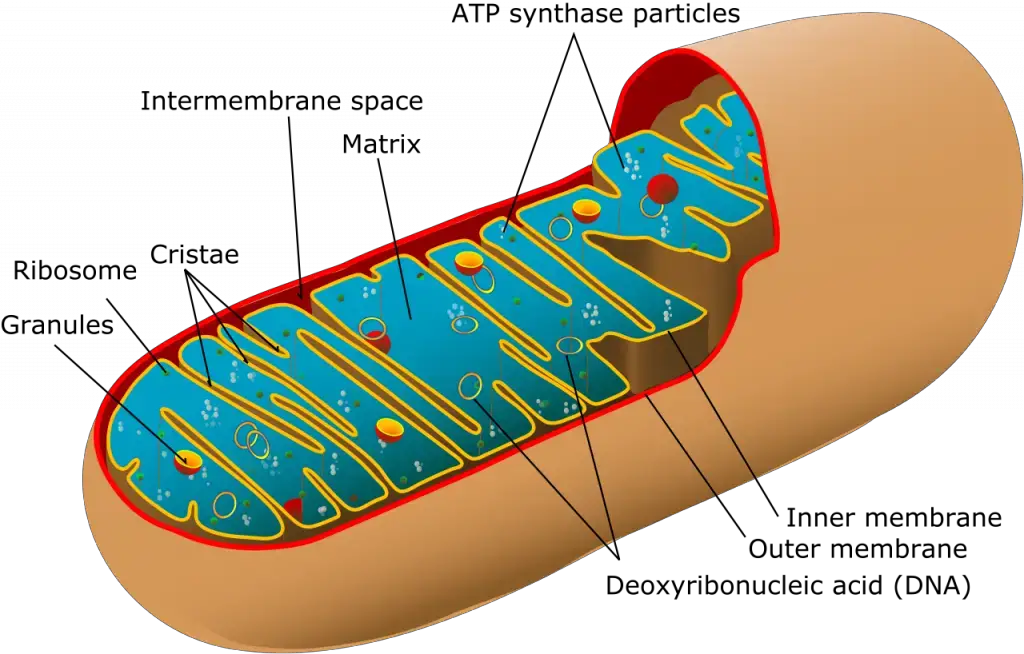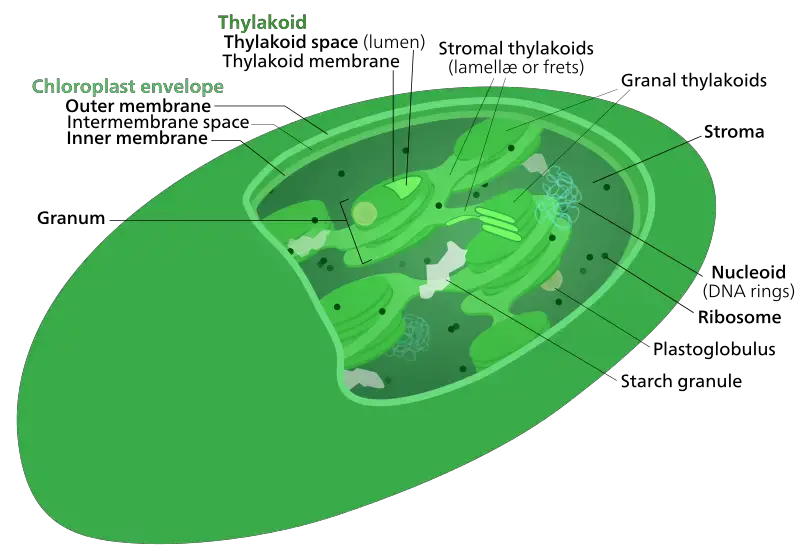What is Mitochondria?
Mitochondria originates of the Greek word meaning’mitos’ thread and ‘chondrios’-granule. Mitochondria are also referred to as the “powerhouse of cells’ because their primary purpose is to generate energy through the process of ATP.
They are rod or bean-shaped structure. The diameter can vary from 0.75-3um and can differs in size. Within a normal cell it takes up about quarter of volume of the cell. In a cell, the quantity of mitochondria that are present is dependent on the needs of metabolism in the specific cell. Therefore, it could be thousands or several. The double membrane, which is both the inner and outer membrane.
The membrane’s outer layer is made from protein and lipid (phospholipid bilayers) and is extremely permeable while also protecting organelles as well. Its inner layer is composed of lipids and protein. The membrane’s inner layer is folded in order to form cristae and the chamber inside is referred to”the matrix.
When it comes to synthesizing energy, which is ATP mitochondria utilize oxygen and nutrients, this process is known”a Aerobic respiration. This is the more efficient method of producing ATP than anaerobic respiration.
Apart from generating fuel for cells, mitochondria also aid with cell signaling, the regulation of cell cycle, development, cell death and in the process of cell differentiation.
The only exception is in Mammalian mature red blood cells in which mitochondria are not present. The theory is that mitochondria were present as a separate prokaryotic cell initially. But because of an endosymbiosis process they were absorbed and became component of the eukaryotic cell. This is the reason that mitochondria carry their own DNA and has a resemblance to Prokaryotic cells (bacteria).
While cellular respiration may not be an easy process it includes three key stages: glycolysis, citric acid cycle or Krebs cycle as well as ATP production. Furthermore it is the case that the ATP produced by mitochondria is utilized by other organelles that are found within the cell.

What is Chloroplast?
Like we said, chloroplast is among the organelles that double-membrane inside the cell. They are present in green plants and algae. Chloroplasts are the place of photosynthesis and has their genome. The complex structure is with a size of approximately 10um and 0.5-2um in the thickness.
The chloroplast’s structure includes the rigid cell wall. The cell wall is the most important thing, as it includes thylakoids, the flat disc shape. A large number of thylakoids make the grana bundle. Grana can be found in the center within the stroma.
The other important aspect is chlorophyll. It is a green-colored pigment and is responsible for absorption of sunlight. It is also found in the the thylakoid. The thylakoid membrane is also home to enzymes as well as other pigments that absorb light which assist to generate energy through ATP (adenosine triphosphate).

Differences Between Mitochondria and Chloroplast Chart (mitochondria vs chloroplasts)
| Basis | Mitochondria | Chloroplast |
| Definition | Mitochondria is an organelle of the cell that is found in all kinds of cells. | A cell organelle called the chloroplast that is present in only plants with green leaves, as well as green algae, and protists. |
| Structure | It’s double membranous. The chamber inside is folded in order to create Cristae. | It also has a double membranous. Its chamber in the inner part has numerous Thylakoid sacks that are stacked over one another. |
| Shape | It’s an oblong or bean-shaped organelle. | It is a disc-shaped an organelle with an ellipsoid shape. |
| Enzymes | A variety of respiratory enzymes are found in it. | There is no respiratory enzyme of the type are found in it. |
| Surface | The surface of the inner layer is larger due to folds that are present in the inner surface. | Its surface area inside is considerably smaller. |
| Chamber names | Its two chambers are referred to for their cristae, and the matrix. | The chambers’ 2 chambers are referred to as thylakoid and stroma. |
| Color | It is not colored. | It’s green because of the presence chlorophyll, the green pigment. |
| Oxygen production or release | It uses oxygen to create energy for the cell. | It is able to liberate oxygen through CO2 and water for the synthesis of glucose. |
| Grana | Cristae do not form grana. | Thylakoids form stacks of disks which are called grana. |
| Energy | It releases energy, in the form of ATP. | It stores energy through glucose. |
| Diameter | Its diameter ranges from 0.75 to 3um. | Its diameter ranges from 5 to 10um and its length is 2.5um. |
| Oxygen | Mitochondria consume oxygen | Chloroplasts liberate oxygen. |
| Raw Materials and End Products | Mitochondria break down glucose into CO2 and H2O. | Chloroplasts use CO2 and H2O in order to build up glucose. |
| Pigments | Mitochondria do not possess any pigments. | The thylakoid membrane in chloroplast contains carotenoids, chlorophyll and photosynthetic pigments. |
| Inner membrane | The inner membrane of mitochondria is folded into cristae. | The inner membrane of the chloroplast rises into flattened sacs called as thylakoids. |
| Found in | Mitochondria are present in the cells of all types of aerobic organisms, like plants and animals. | Chloroplast is present in green plants and green algae, protists like Euglena. |
| Function | Provide energy to the cell in the form of ATP | Performs photorespiration and photosynthesis |
| Etymology | Greek words: “Mitos” means “thread” and “chondrios” means “granule.” | Greek words: “Khloros” means “green” and “plastos” means “formed.” |
| Processes | Mitochondria are a site of electron transport chain, oxidative phosphorylation, beta oxidation and photorespiration. | Photosynthesis and photorespiration occur in the chloroplast. |
| Other characteristics | 1. Mitochondria convert sugar (glucose) into chemical energy called as ATP (adenosine triphosphate), 2. It consumes oxygen, 3. Mitochondria release energy by the breakdown of the organic food and produce carbon dioxide and water, 4. Mitochondria are the site of beta oxidative, photorespiration, oxidative phosphorylation, ETC. | 1. In the chemical bonds of glucose, the solar energy is stored, 2. It liberates or releases oxygen. 3. Chloroplast helps in storing the energy and uses carbon dioxide and water to make glucose (energy). 4. The chloroplast is the site of the photorespiration and photosynthesis. |
| Reactions that occur | The reactions that occur in it include beta-oxidation, respiration and the oxidative and phosphorylation. | The reactions that take place within it include photosynthesis and photorespiration. |
Similarities between mitochondria and chloroplasts
- Both are double membrane structures.
- Each organelle is home to their DNA and their RNA.
- Both provide energy to cells.
- Both organelles contain enzymes and coenzyme.
- The role of carbon dioxide and oxygen.
- A different characteristic is the fact that both organelles are able to be moved from one location to another inside the cell.
Key Differences Between Mitochondria and Chloroplast
Here are the major differences between the two main organelles inside the cell:
- Mitochondria is the big organelle with a membrane that is found in virtually every kind of eukaryotic species often referred to as the “the cell’s powerhouse.”. Mitochondria are accountable for cells’ respiration as well as energy metabolism. However, Chloroplast is exclusively in plants of the green variety, and in some algae They are the main sites of photosynthesis. This cell organelle is more intricate and bigger than mitochondria.
- Mitochondria are found in cells of all kinds of aerobic organisms, including animals and plants. Chloroplast is found in green plants, as well as algae, protists and algae like Euglena. Mitochondria is the colorless, organelles with the shape of beans. Chloroplasts are green in colour and disc-shaped organelles.
- Mitochondria and Chloroplast contain two chambers within them , which are the matrix and the cristae that are found in mitochondria, stroma, as well as the thylakoids of the chloroplast.
- The membrane that surrounds mitochondria can be folded in cristae, while the chloroplast’s membrane is flattened into sacs known as thylakoids.
- The thylakoid membrane inside the chloroplast has carotenoids and chlorophyll, as well as photosynthetic pigments. These are not present in mitochondria. Mitochondria change sugar (glucose) into chemical energy known in an ATP (adenosine triphosphate) which utilizes oxygen to release energy by breaking down organic food chain, and then creates carbon dioxide and water. In chloroplast , sunlight is stored. this organelle assists in conserving energy, it uses water and carbon dioxide to create glucose. Chloroplast releases oxygen.
- Mitochondria are the place for beta photorespiration, oxidative phosphorylation ETC. Chloroplast is the place for photosynthesis and photorespiration.
- Text Highlighting: Select any text in the post content to highlight it
- Text Annotation: Select text and add comments with annotations
- Comment Management: Edit or delete your own comments
- Highlight Management: Remove your own highlights
How to use: Simply select any text in the post content above, and you'll see annotation options. Login here or create an account to get started.